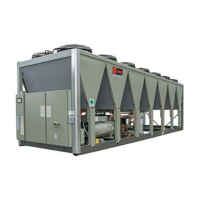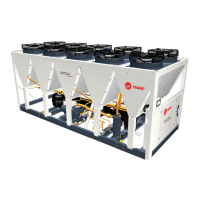RLC-SVX19G-GB
98
4 UNT-PRC002-GB
Technical Data
FWD 08 12 20 30 45
Power supply (V/Ph/Hz) 230/1/50
Capacities
Cooling capacity on water (1) (kW) 5,2 8,3 15 18,8 30,1
Heating capacity on water (2) (kW) 6,3 11,9 18,9 20,9 38,2
Fan motor (type) 2 x direct drive centrifugal
Fan power input (3) (kW) 0,23 0,46 0,65 1,04 1,51
Current amps (3) (A) 1,1 2,2 3,1 4,7 5,5
Start-up amps (A) 3,2 5,5 9,3 14,1 16,5
Air flow
minimum (m
3
/h) 490 980 1400 1800 2700
nominal (m
3
/h) 820 1650 2300 3000 4500
maximum (m
3
/h) 980 1970 2600 3600 5400
Main coil
Water entering/leaving connections (type) ISO R7 rotating female
(Dia) 3/4" 3/4" 1 1/2" 1 1/2" 1 1/2"
Electric heater (accessory for blower only)
Electric power supply (V/Ph/Hz) 230/1/50 230/1/50 or 400/3/50 400/3/50 400/3/50 400/3/50
Heating capacity (kW) 2/4 8 10 12 12
Hot water coil (accessory for blower only)
Heating capacity (4) (kW) 6,3 12 17,4 22,4 34,5
G2 filter (filter box accessory)
Quantity 2 2 2 2 2
Dimensions ( LxWxth) (mm) 386x221x8 486x271x8 586x321x8 586*421*8 586*621*8
G4 filter (filter box accessory)
Quantity - 2 2 2 2
Dimensions ( LxWxth) (mm) - 486x264x48 586x314x48 586*414*48 586*614*48
Condensate pump (accessory) (type) Centrifugal
Water flow - lift height (l/h - mm) 24 - 500
Not available for FWD30 and FWD45
Sound level (L/M/H speed)
Sound pressure level (5) (dB(A)) 36/40/43 38/41/44 46/50/53 47/52/57 47/52/58
Sound power level (5) (dB(A)) 46/50/53 48/51/54 56/60/63 57/62/67 57/62/68
Unit dimensions
Width x Depth (mm) 890 x 600 1090 x 710 1290 x 820 1290 x 970 1290 x 1090
Height (mm) 250 300 350 450 650
Shipped unit dimensions
Width x Depth (mm) 933 x 644 1133 x 754 1333 x 864 1333 x 1008 1333*1133
Height (mm) 260 310 360 460 660
Weight (kg) 32 46 61 76 118
Colour galvanised steel
Recommended fuse size
Unit alone (aM/gI) (A) 8/16 8/16 8/16 8/25 8/25
Unit with electric heater (gI) (A) 16 (2kW),25 (4kW) 40 (230V),3*16 (400V) 3*20 3*25 3*25
(1) Conditions: Water entering/leaving temperature: 7/12 °C, Air inlet temperature 27/19°C DB/WB - Nominal air flow
(2) Conditions: Water entering/leaving temperature: 50/45 °C, Air inlet temperature 20°C DB - Nominal air flow
(3) At high speed with nominal air flow.
(4) Water entering/leaving temperature 90/70 °C, air inlet temperature 20 °C DB, Nominal air flow.
(5) A rectangular glass wool duct 1m50 long is placed on the blower.The measurement is taken in the room containing the blower unit.
Heat exchanger operating limits:
FWD:
*water temperature: max 100° C
*absolute service pressure: min 1 bar/max 11 bars
Accessories - Hot water coil:
*water temperature: min. +2° C/max. 100° C
*absolute service pressure: min 1 bar/max 11 bars
Installation Requirements
Dimension and Weights
Dimensions details, dimensions of hydraulic
connections, electrical connections, isolator positioning,
specific features for heat recovery and free cooling
are included in submittals and diagrams provided in
documentation package.
Center of Gravity
See instructions on lifting drawings available on request.
WARNING! Heavy Objects!
Ensure that all the lifting equipment used is properly
rated for weight of the unit being lifted. Each of the
cables (chains or slings), hooks, and shackles used to lift
the unit must be capable of supporting the entire weight
of unit. Lifting cables (chains or slings) may not be the
same length. Adjust as necessary for even unit lift. Other
lifting arrangements could cause equipment or property
damage. Failure to follow instructions above or properly
lift unit could result in unit dropping and possibly
crushing operator/technician which could result in death
or serious injury.
WARNING! Improper Unit Lift!
Test lift unit approximately 10 cm to verify proper center
of gravity lift point. To avoid dropping of unit, reposition
lifting point if unit is not level. Failure to properly lift
unit could result in unit dropping and possibly crushing
operator/technician which could result in death or
serious injury and possible equipment or property- only
damage.
Clearances
When installing the unit, provide enough space around
the unit to allow the installation and maintenance
personnel unrestricted access to all service points.
Unobstructed flow of condenser air is essential to
maintain chiller capacity and operating efficiency. When
determining unit placement, give careful consideration
to ensuring a sufficient air flow across the condenser
coils heat-transfer surface.
Notes:
1. Area above unit required for operation, maintenance,
panel access and airflow: NO OBSTRUCTIONS ABOVE
UNIT
2. For installations with obstructions or multiple units,
refer to Trane office for Close Spacing and Restricted
Airflow advices.
3. Minimum clearance of 1990 mm on the side of the
unit is required for coil replacement. If sufficient
clearance is not available on the side of the unit, coil
replacement should be performed through top of unit.
4. Enough clearance is required in front of the control
panels. Must be measured from front of panel, not end
of unit base.
5. Clearances should be sufficient for tube pull out of
evaporator (2.5 m in the evaporator water box side of
the unit for 2 compressors units and 4.5 m for 3 and
4 compressors units)
6. Refer to submittal drawings for complementary
information.
Unit Isolation and Leveling
Provide a foundation with sufficient strength and mass
to support the unit operating weight (that is, including
completed piping, full operating charges of refrigerant
and oil, and water). Refer to unit operating weights.
The unit must be leveled within 5 mm over its length
and width. Use shims as necessary to level the unit. For
additional reduction of sound and vibration, install the
optional elastomeric isolators.
Sound consideration
The most effective form of acoustical isolation is to
locate the unit away from any sound sensitive area.
Structurally transmitted sound can be reduced by
elastomeric vibration eliminators. Spring isolators are
not recommended. Consult an acoustical engineer in
critical sound applications.
For maximum isolation effect, isolate water lines and
electrical conduit. Rubber isolated piping hangers can
be used to reduce the sound transmitted through water
piping. To reduce sound transmitted through electrical
conduit, use flexible electrical conduit.
EU and Local Regulations codes on sound emissions
should always be considered. Since the environment
in which a sound source is located affects the sound
pressure, unit placement must be carefully evaluated.

